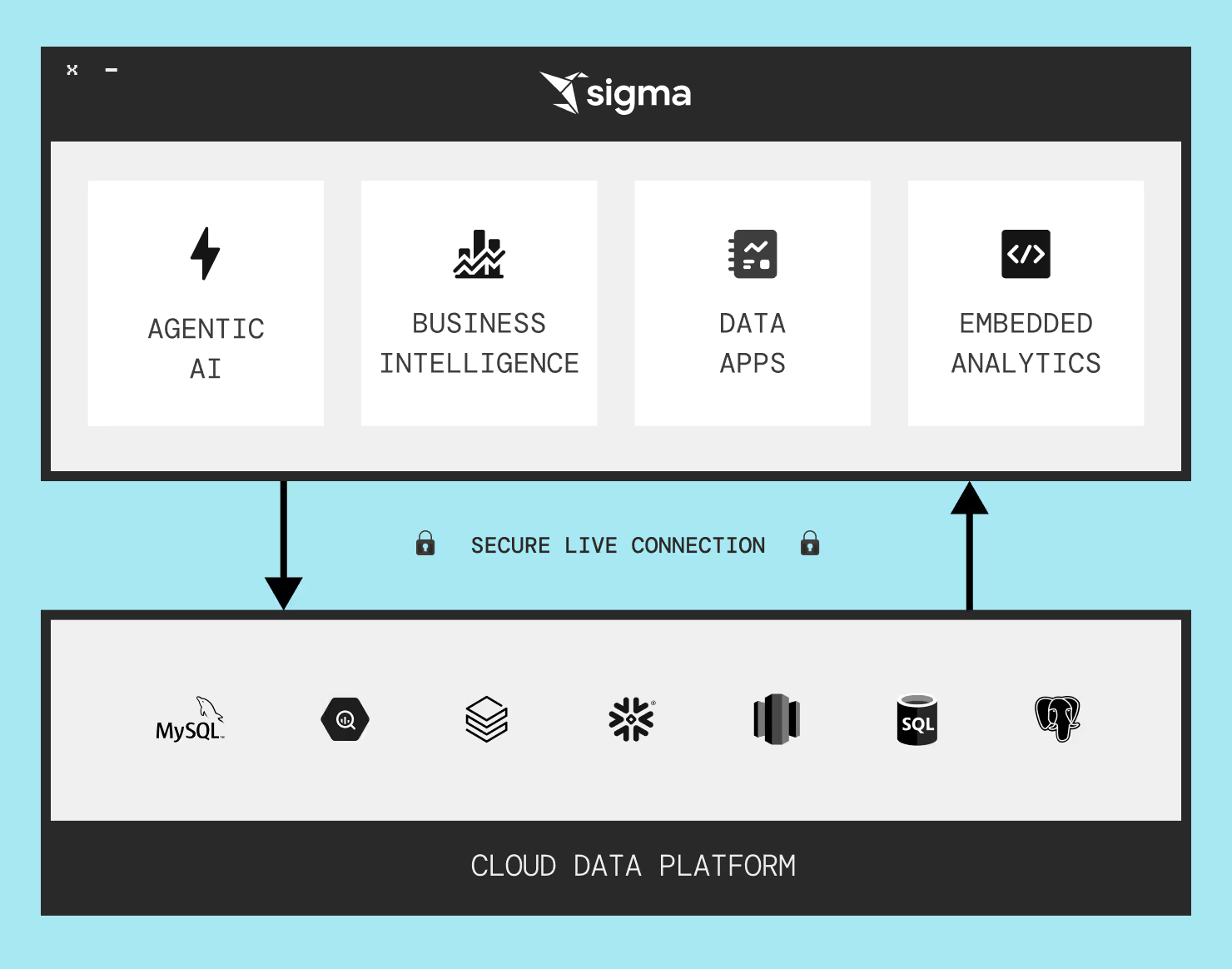Building the Next Chapter of Sigma with AI and ML
Table of Contents

Earlier this year, I joined Sigma to accelerate our AI/ML development. Sigma has been on a phenomenal trajectory: over 1,500 customers, $100M+ ARR, and an unmistakable momentum in helping organizations make better, faster, data-informed decisions.
It was immediately clear that AI and ML would accelerate that success going forward. Today, I want to share why I joined Sigma, what I see as our opportunity with AI/ML, and how we’re approaching this next chapter with both ambition and responsibility.
Why I Joined
There is a lot to admire about Sigma: diverse customers across industries and markets, sky-high user satisfaction, and accelerating adoption. Through the lens of Sigma’s AI/ML opportunity, three key points stood out for me:
#1: Sigma is incredibly versatile
The breadth and depth of Sigma’s capabilities is outstanding. In Sigma, you can connect to multiple data warehouses, explore trillions of records, create dashboards and reports, collect data through Input Tables, distribute Sigma to your own customers through Embeds, and build full-fledged enterprise data apps—without writing a line of code or setting up any infrastructure.
This versatility is akin to game engines, an analogy I cannot resist making, having spent eight years building AI/ML products at EA and Unity. Game engines can be used by both students building simple 2D games and a team of industry veterans building a massively multiplayer open world game. Sigma has that same versatility, and I’m constantly energized by the creativity of our customers and teams in how they use it.
#2: Sigma’s platform integrations are unmatched
Early on, Sigma made the deliberate and thoughtful decision to lean heavily into cloud data warehouses. As such, and over many years of investment, Sigma isn’t just connected to your warehouse; it’s woven into it — at the data, semantic, security, and AI layers.
This offers compounding benefits to our customers who can explore, build, and analyze in Sigma across multiple data warehouses in a consistent and reliable way. Every analysis, every permission, every query runs natively where your data lives — the kind of foundation you need if you want to build AI responsibly and at scale.

#3: Sigma’s customers are exceptional
From my first day, I was blown away by the diversity of Sigma’s customer base—by size, industry, and use case. More striking was the love that our customers have for the product. Every conversation carries the perfect blend of what they love about Sigma and where we can continue to provide value, earn more trust and deepen the relationship.
As a result, our customers tend to grow their Sigma adoption over time, with more users, departments and use-cases. That spirit of partnership is exactly what’s needed to build AI systems that work in the real world.
Sigma’s AI Opportunity
For the past 21 years, I have been fascinated by artificial intelligence and machine learning and its ability to transform domains and industries. Starting from my early days as an undergraduate researcher, I built ML models that classified plankton species from images collected underwater to empower marine biologists. In graduate school, as a Google intern, I built large-scale predictive ML models for Google Maps.
My PhD thesis focused on unsupervised ML models for detecting abnormal electrocardiograms (EKGs) and removing magnetic bias from MRI scans for radiologists. After my PhD, I spent 8 years in the gaming industry building AI/ML systems that powered recommendations, managed virtual economies and learned to play games. Then, during my time at Scale AI, I had a front row seat to the rise of foundation models and the infrastructure needed to train and host them.
Throughout this journey, I’ve seen AI/ML “hot topics” evolve. From kernel methods to probabilistic graphical models to deep learning to (deep) reinforcement learning to foundation models to agentic systems.
I’ve also witnessed the hype cycles come and go, but beneath it all was an undercurrent of real progress that has continued to accelerate over the years. AI/ML has been a true technological shift. Those that stand to benefit from it are those that understand it for what it is: not a silver bullet, but an evolving technology that is highly capable, yet flawed. It’s those that appreciate the large gap that exists between building a prototype and a real system that not only works, but gets better over time. This is our view at Sigma and it underpins our AI/ML development. We’re in it for the long haul.
Sigma’s mission is to enable everyone in your organization to make data-informed actions. Over years of investment, Sigma has built the foundation to realize this mission: a set of capabilities for data exploration, analysis, and decisioning built on top of your data warehouse with enterprise security and governance. We firmly believe that AI/ML will be an accelerant. Our vision is that Sigma, with AI/ML, will become a data productivity engine that is personalized, autonomous, and everywhere.
Personalized, autonomous, everywhere
Let’s unpack this.
- Personalized means that Sigma understands your organization and users deeply and can tailor your experience accordingly.
- Autonomous means that Sigma can proactively do work for you, in the background, before you need it.
- Everywhere, means that Sigma will leverage resources beyond your warehouse, and can be integrated into other third party tools, whether as plugins to your favorite enterprise app or through Model Context Protocol (MCP) within your organization’s central chat experience.
The end state is an intelligent data productivity engine tailored to your organization that can accelerate your organization's time to act. All you have to do is point it to your data warehouse.
AI-assisted capabilities in Sigma
The road to autonomy begins with assistive capabilities. Our immediate goal is to develop AI/ML capabilities across four pillars:
- Discover: Powerful search, recommendations, and personalization to help people find the right data sources, data models, and workbooks quickly.
- Analyze: Simplify access to and understanding of data through AI-assisted question-answering, analysis, and deep research that takes advantage of Sigma’s powerful data exploration capabilities.
- Build: Accelerate the creation of data models, explorations, data apps and AI-powered workflows through natural language, making it trivial for any member of your organization to build and customize.
- Unleash: Extend Sigma’s AI capabilities beyond the warehouse — to documents, APIs, Agents and MCP.
We’ve already made significant progress in all these areas: Ask Sigma is available to customers now and AI Builder is being tested in Private Beta. And we’re just warming up—expect a number of important updates in the coming months!
Operational principles that keep us honest
One of the most important aspects of AI/ML development is execution. And it's frankly where many companies and teams go wrong with accelerating AI/ML adoption. As such, we have internally laid out a number of Operationalizing AI principles. I’d like to share three of them.
First, UX Matters Most. We greatly value and prioritize our user experience. AI/ML should influence and inform that user experience, not define it.
Second, AI Everywhere. AI/ML will be an important accelerant in all our product areas, not a bolted-on feature. As such, instead of consolidating AI/ML development into a single team, every product team will leverage AI/ML to accelerate their domain.
Third, Beyond the Checkbox. Building prototypes is increasingly trivial and it's frankly easy for any product team to add AI capabilities and “check the box.” Our focus is to ship AI capabilities that work reliably, that are mindful of our users and directly optimize their experience.
Recap
This next phase of Sigma’s evolution is beyond exciting. With a focus on the entire lifecycle from data discovery to data apps and workflows, Sigma is uniquely positioned to enable every user of every organization to take data-informed actions. AI/ML will be the fuel that accelerates this development and we’ll accomplish this in the principled and responsible way that our users have come to expect from us over the years. Onwards.
Join Us
If you’re excited to work on some of the most challenging problems at the intersection of data and AI - join us! We’re hiring AI/ML Engineers and Interns across SF and NY.













